
Paul Matisse (born 1933) is an artist and inventor known for his public art installations, many of which are interactive and produce sound. Matisse also invented the Kalliroscope.

Paul Matisse (born 1933) is an artist and inventor known for his public art installations, many of which are interactive and produce sound. Matisse also invented the Kalliroscope.
| | This section needs expansion. You can help by adding to it. (May 2019) |
Paul Matisse is the son of New York gallery owner Pierre Matisse, (the youngest son of painter Henri Matisse), and Alexina Sattler. His mother later divorced Pierre and married artist Marcel Duchamp, becoming Alexina "Teeny" Duchamp. Thus Paul is both grandson of Henri Matisse, and the stepson of Marcel Duchamp. [1]
In 1954, Matisse graduated from Harvard University. [1] Matisse studied at Harvard's Graduate School of Design, and worked briefly with Buckminster Fuller. [2]
| | This section needs expansion. You can help by adding to it. (May 2019) |
Matisse worked in product development for Arthur D. Little. [2] In 1962 he set off on his own, inventing (1966), patenting (1968), and ultimately manufacturing Kalliroscopes, which can display the complex and otherwise-invisible flow of liquids. [3]
After the death of his stepfather Marcel Duchamp in 1968, Matisse worked with his widowed mother Alexina "Teeny" Duchamp and curator Anne d'Harnoncourt to implement the posthumous installation of Duchamp's artwork Étant donnés at the Philadelphia Museum of Art. [4]
Matisse currently resides in a former Baptist church in Groton, Massachusetts. [1] [2] His daughter Sophie Matisse is an artist in New York City. His son, Alex Matisse, is a pottery artist and founder of East Fork Pottery in North Carolina. [5] His granddaughter is actress Gaïa Jacquet-Matisse.

Henri-Robert-Marcel Duchamp was a French painter, sculptor, chess player, and writer whose work is associated with Cubism, Dada, and conceptual art. He is commonly regarded, along with Pablo Picasso and Henri Matisse, as one of the three artists who helped to define the revolutionary developments in the plastic arts in the opening decades of the 20th century, responsible for significant developments in painting and sculpture. He has had an immense impact on 20th- and 21st-century art, and a seminal influence on the development of conceptual art. By the time of World War I, he had rejected the work of many of his fellow artists as "retinal", intended only to please the eye. Instead, he wanted to use art to serve the mind.
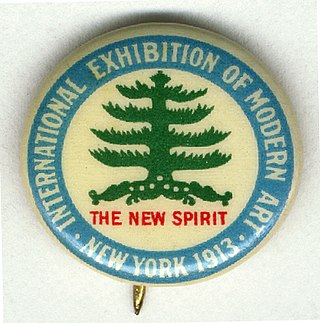
The 1913 Armory Show, also known as the International Exhibition of Modern Art, was organized by the Association of American Painters and Sculptors. It was the first large exhibition of modern art in America, as well as one of the many exhibitions that have been held in the vast spaces of U.S. National Guard armories.
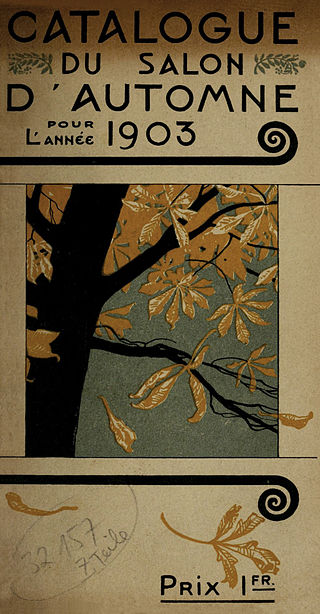
The Salon d'Automne, or Société du Salon d'automne, is an art exhibition held annually in Paris. Since 2011, it is held on the Champs-Élysées, between the Grand Palais and the Petit Palais, in mid-October. The first Salon d'Automne was created in 1903 by Frantz Jourdain, with Hector Guimard, George Desvallières, Eugène Carrière, Félix Vallotton, Édouard Vuillard, Eugène Chigot and Maison Jansen.

Kendall/MIT station is an underground rapid transit station in Cambridge, Massachusetts. It serves the MBTA Red Line, Located at the intersection of Main Street and Broadway, it is named for the primary areas it serves - the Kendall Square business district and the Massachusetts Institute of Technology (MIT). Opened in March 1912 as part of the original Cambridge subway, Kendall/MIT has two side platforms serving the line's two tracks. The Kendall Band, a public art installation of hand-operated musical sculptures, is located between the tracks in the station with controls located on the platforms. Kendall/MIT station is accessible. With 17,018 weekday boardings by a FY2019 count, Kendall/MIT has the fourth highest ridership among MBTA subway stations.

Louis Michel Eilshemius was an American painter, primarily of landscapes and nudes. He also wrote musical compositions, verse, novels, short stories, and published periodicals.
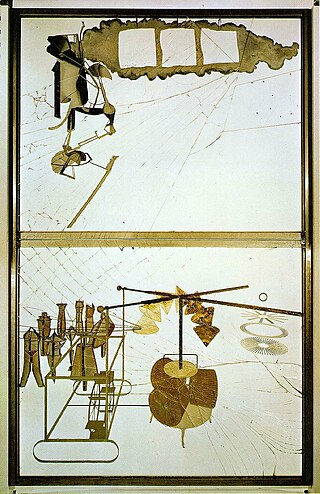
The Bride Stripped Bare by Her Bachelors, Even, most often called The Large Glass, is an artwork by Marcel Duchamp over 9 feet (2.7 m) tall and almost 6 feet (1.76m) wide. Duchamp worked on the piece from 1915 to 1923 in New York City, creating two panes of glass with materials such as lead foil, fuse wire, and dust. It combines chance procedures, plotted perspective studies, and laborious craftsmanship. Duchamp's ideas for the Glass began in 1912, and he made numerous notes and studies, as well as preliminary works for the piece. The notes reflect the creation of unique rules of physics, and myth which describes the work.

Fountain is a readymade sculpture by Marcel Duchamp in 1917, consisting of a porcelain urinal signed "R. Mutt". In April 1917, an ordinary piece of plumbing chosen by Duchamp was submitted for an exhibition of the Society of Independent Artists, the inaugural exhibition by the Society to be staged at the Grand Central Palace in New York. When explaining the purpose of his readymade sculpture, Duchamp stated they are "everyday objects raised to the dignity of a work of art by the artist's act of choice." In Duchamp's presentation, the urinal's orientation was altered from its usual positioning. Fountain was not rejected by the committee, since Society rules stated that all works would be accepted from artists who paid the fee, but the work was never placed in the show area. Following that removal, Fountain was photographed at Alfred Stieglitz's studio, and the photo published in the Dada journal The Blind Man. The original has been lost.

Alexina "Teeny" Duchamp was the wife of Pierre Matisse, daughter-in-law of artist Henri Matisse, and second wife of artist and chess player Marcel Duchamp.
Twentieth-century art—and what it became as modern art—began with modernism in the late nineteenth century.
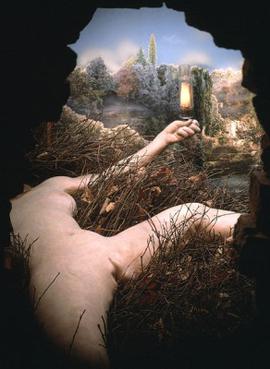
Étant donnés is a 1966 assemblage by Marcel Duchamp. It was his last major artwork, surprising viewers and critics who had widely believed he had given up art; he was previously pursuing competitive chess which he had been playing for almost 25 years. The artwork is a tableau, visible only through a pair of peepholes—one for each eye—in a wooden door, of a nude woman lying on her back on a hill with her face hidden, legs spread, holding a gas lamp in the air in one hand against a landscape backdrop.
Pierre Matisse was a French-American art dealer active in New York City. He was the youngest child of French painter Henri Matisse.
Anne Julie d'Harnoncourt was an American curator, museum director, and art historian specializing in modern art. She was the director and CEO of the Philadelphia Museum of Art (PMA), a post she held from 1982 until her sudden death in 2008. She was also an expert scholar on the works of French artist Marcel Duchamp.

The Charles River Dam is a flood control structure on the Charles River in Boston, Massachusetts, located just downstream of the Leonard P. Zakim Bunker Hill Memorial Bridge, near Lovejoy Wharf, on the former location of the Warren Bridge.

Boston Harborwalk is a public walkway that follows the edge of piers, wharves, beaches, and shoreline around Boston Harbor. When fully completed it will extend a distance of 47 miles (76 km) from East Boston to the Neponset River.
Hannah Smith (1897–1960) was an American arts patron, philanthropist, and advocate for social change. Legendary for her salon parties, she enjoyed being the conduit for many unlikely meetings and collaborations. In 1938, when a significant number of European artists were fleeing Europe, she started the Hannah Smith Agency in New York City. The Agency represented a select group of artists and thinkers, embodying Smith’s knack for collecting artists and ideas.
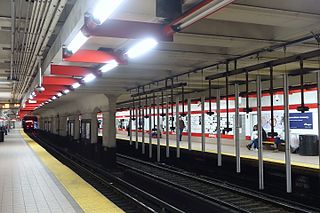
The Kendall Band is a three-part musical sculpture created between 1986 and 1988 by Paul Matisse, who is the grandson of French artist Henri Matisse and stepson of surrealist artist Marcel Duchamp. It is installed between the inbound and outbound tracks of the Massachusetts Bay Transportation Authority's Kendall Station located in Cambridge, Massachusetts near the MIT campus. As of 2007, the art work was seen by an estimated 12,518 riders on an average weekday. It had originally cost $90,000 to construct.
Sophie Alexina Victoire Matisse is an American contemporary artist. Matisse initially gained notice for her series of Missing Person paintings, in which she appropriated and embellished upon, or subtracted from, recognizable works from art history.

Maria Martins was a Brazilian visual artist who was particularly well known for her modern sculptures.

La Boîte-en-valise is a type of mixed media assemblage by Marcel Duchamp consisting of a group of reproductions of the artist's works inside a box that was, in some cases, accompanied by a leather valise or suitcase. Duchamp made multiple versions of this type between 1935 and 1966. Titled From or by Marcel Duchamp or Rrose Sélavy (de ou par Marcel Duchamp ou Rrose Sélavy [Boîte-en-valise], Duchamp conceived of the boxes as a portable museum:
Instead of painting something new, my aim was to reproduce the paintings and objects I liked and collect them in as small a space as possible. I did not know how to go about it. I first thought of a book, but I did not like the idea. Then it occurred to me that it could be a box in which all my works would be collected and mounted like in a small museum, a portable museum, so to speak. This is it, this valise.